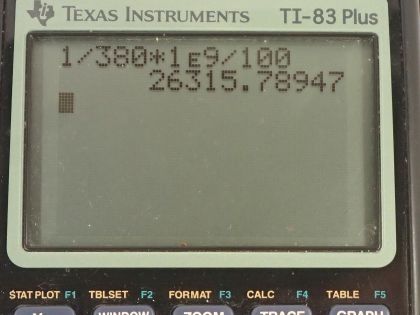Question
(a) Find the maximum number of lines per centimeter a diffraction grating can have and produce a maximum for the smallest wavelength of visible light. (b) Would such a grating be useful for ultraviolet spectra? (c) For infrared spectra?
Final Answer
- Yes, the grating will be useful for ultraviolet light since
- No, this grating will not be useful for infrared light since
Solution video
OpenStax College Physics, Chapter 27, Problem 36 (Problems & Exercises)

vote with a rating of
votes with an average rating of
.
Calculator Screenshots
Video Transcript
This is College Physics Answers with Shaun Dychko. We want to know the maximum number of lines per centimeter a diffraction grating can have and produce a maximum for the smallest wavelength of visible light. So we need to look up what the smallest wavelength of visible light is and that's 380 nanometers—ultraviolet— and this formula here will tell us the spacing between lines in the diffraction grating and then we can figure out what the lines per centimeter will be after we figure out, you know, number of meters between each line which is what d is. Alright! So we can solve for d by dividing both sides of this by sin Θ and now we have d then— the spacing between lines in the diffraction grating— is the order of the maximum multiplied by the wavelength of the light divided by sin of the angle to that maximum. Now we want to minimize this spacing between lines because that will pack the maximum possible number of them in a centimeter so the spacing between has to be minimized so we are minimizing d and that means maximizing the denominator of this fraction so a big denominator will reduce the quotient and so we have to maximize sin Θ and we want to minimize the numerator and the only number we can play with is m because λ is fixed at 380—the shortest wavelength of light— and so minimizing m means that we choose the number 1 for m and maximizing sin Θ means we have to take the number 1 because the sin graph shows a maximum value at 1 the range of the sin function is the range of the sin function is from negative 1 up to 1 you can't have a number greater than 1 for sin Θ. Okay! So that means plug in 1 for m and 1 for sin Θ and this means the spacing between lines is the wavelength so that's 380 nanometers and we can turn this into the number of lines per centimeter by saying that we have 1 line for every 380 nanometers and then we multiply that by 1 times 10 to the 9 nanometers for every meter so the nanometers cancel and then multiply by 1 meter for every 100 centimeters so the meters cancel and we are left with 26300 lines per centimeter. In part (b) we are asked will this diffraction grating be useful for ultraviolet light? And so ultraviolet light is going to be a wavelength less than 380 nanometers—a shorter wavelength— we know that d is 380—that's what we figured out in part (a)— and we can choose m to be 1 in order to minimize this right-hand side and with m equal to 1 then we have the wavelength of the ultraviolet light divided by d and since this is going to be a number less than 1 that is good because this ultraviolet wavelength is less than 380 d is 380 so the numerator's smaller than the denominator and so this quotient is less than 1 and so yes the grating will be useful for ultraviolet because then we'll have sin of this angle being less than 1 as it needs to be because otherwise the angle would be undefined because again referring to this graph sin has to be less than 1. Okay! Then consider infrared light in that case, we'll have the wavelength of the infrared on the top here divided by the same spacing between lines and the infrared wavelength is going to be greater than 760 nanometers and that's going to make this fraction greater than 1 even though we have reduced it as much as we can by choosing m at its minimum of 1; in this case when you solve both sides or solve this for Θ I.R. by taking the inverse sin of both sides we'll get then that the angle to this hypothetical maximum for the infrared light will be the inverse sin of a number greater than 1 because this numerator is bigger than the denominator and that's not possible— that's undefined— your calculator will complain and say can't do it. So no, this grating will not be useful for infrared light.
